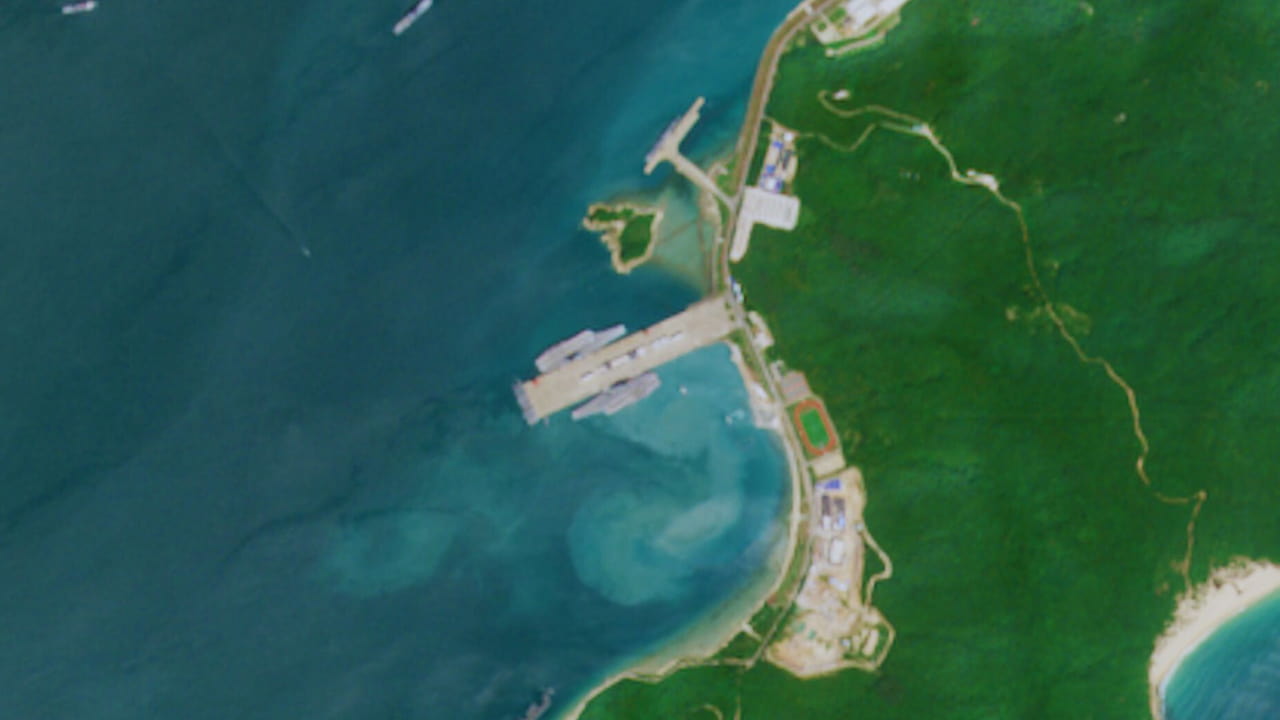China Flexes Naval Muscle: Twin Carriers Dock in South China Sea
In a rare display of naval might, China’s two operational aircraft carriers were recently spotted docked side by side at a strategic base in the South China Sea. This unexpected sighting has sparked discussions about Beijing’s growing maritime ambitions and its implications for regional security.
A Surprising Satellite Snapshot
On Tuesday, a satellite image captured an unusual scene at Sanya Naval Base on Hainan Island. The Liaoning and Shandong, China’s only two active aircraft carriers, were seen pier-side together. This marks a significant moment, as seeing both vessels at the exact location is uncommon.
The image, provided by space intelligence firm BlackSky, shows the carriers docked at the same pier. This base, located just east of Vietnam, is a critical outpost in China’s naval strategy for the South China Sea region.
The Liaoning: From Soviet Hulk to Chinese Pride
The Liaoning, China’s first aircraft carrier, has an interesting backstory. It started life as an unfinished Soviet-era ship. In the late 1990s, China bought the stripped-down hull and transformed it into a fully functioning carrier. The ship entered service in 2012 but wasn’t deemed ready for combat until 2016.
Looking at the Liaoning, you might notice its resemblance to Russia’s Admiral Kuznetsov carrier. This similarity isn’t surprising, given their shared origins.
The Shandong: China’s Home-Grown Carrier
While the Liaoning was China’s first step into carrier operations, the Shandong represents a leap forward. As China’s first domestically-built carrier, it showcases the country’s growing shipbuilding skills. The Shandong joined the fleet in 2019, expanding China’s ability to project power at sea.
Though based on the Liaoning’s design, the Shandong boasts some upgrades. It can carry more aircraft, particularly the J-15 fighters that form the backbone of China’s carrier air wings. Both ships feature a ski-jump-style ramp for launching planes, a design that differs from the flat decks used by U.S. carriers.
The Future: Enter the Fujian
While the Liaoning and Shandong make headlines, China’s newest carrier, the Fujian, waits in the wings. Currently undergoing sea trials, the Fujian represents a technological leap. Unlike its predecessors, it features an advanced catapult system for launching aircraft, similar to those used on the latest U.S. carriers.
Recent Operations and Regional Tensions
Before their reunion at Sanya, the Liaoning and Shandong were busy with separate exercises. The Liaoning conducted drills in the Western Pacific, while the Shandong wrapped up operations in the South China Sea.
These naval maneuvers come at a time of heightened tensions in the region. China has clashed with its neighbors, particularly the Philippines, over disputed territories in the South China Sea. Recent incidents include Chinese vessels using water cannons against Philippine ships near the Scarborough Shoal, an area China claims despite international rulings to the contrary.
A Show of Force or Routine Maintenance?
The presence of both carriers at Sanya raises questions. Are they preparing for joint exercises, or is this a coincidence of maintenance schedules? China hasn’t announced plans for dual-carrier operations, but the capability to do so would significantly boost its naval power.
The Bigger Picture
China’s aircraft carrier program is vital to its military modernization efforts. By building a carrier fleet, China aims to protect its interests farther from its shores and challenge U.S. naval dominance in the Pacific.
However, it’s worth noting that China’s carrier force is still relatively new and inexperienced compared to the U.S. Navy, which has been operating carriers for decades. The U.S. has 11 nuclear-powered supercarriers, each significantly more extensive and capable than China’s conventional carriers.
Looking Ahead
As China continues to develop its carrier program, neighboring countries and the United States are watching closely. The ability to deploy multiple carriers could significantly alter the balance of power in the South China Sea and beyond.
For now, the image of the Liaoning and Shandong side by side serves as a powerful symbol of China’s naval ambitions. Whether this marks the beginning of more frequent dual-carrier operations or remains a rare occurrence, it’s clear that China’s maritime capabilities are evolving rapidly.
As tensions simmer in the South China Sea, the world will closely monitor China’s aircraft carriers and their future deployments. The dance of diplomacy and military posturing in these contested waters is far from over.
Table of Contents
